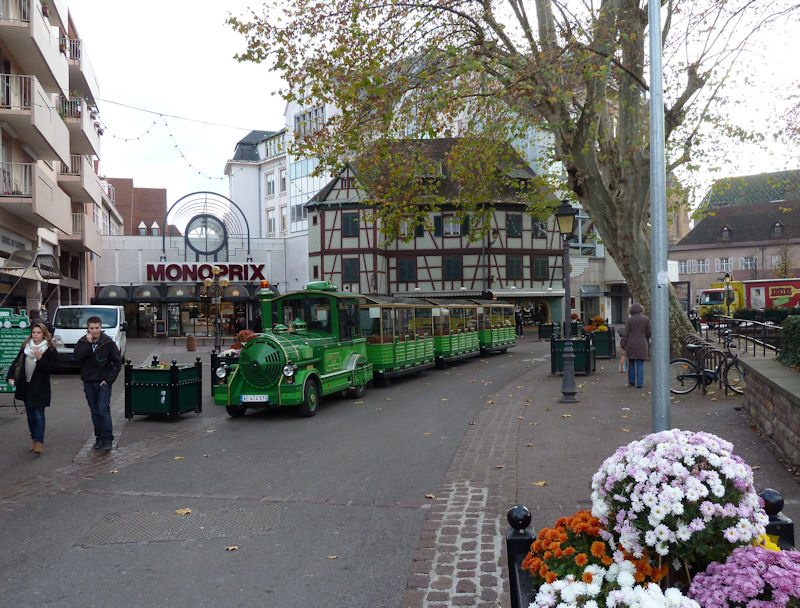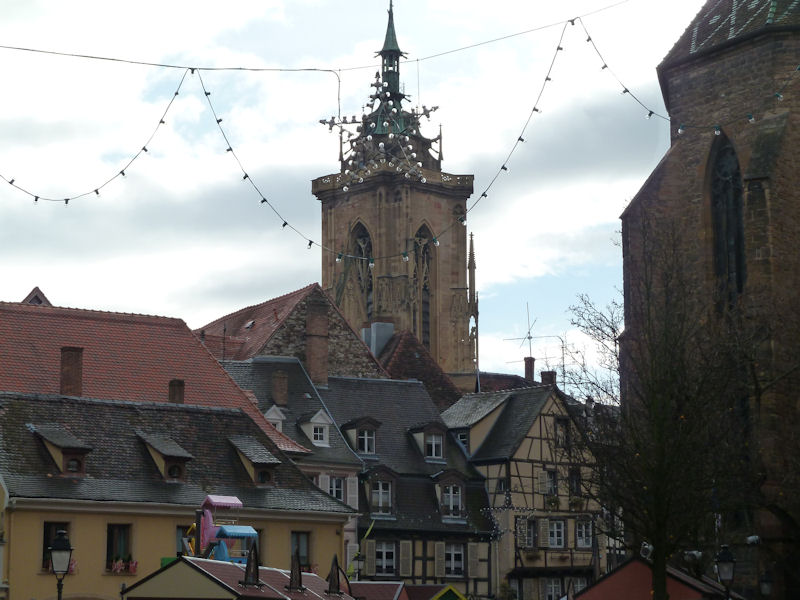You may not find this terribly rewarding unless you're included here, so this is a good time for casual and random browsers to turn back before they get too caught up in the sweep and majesty of the proceedings and can't let go.
We've alighted at the Colmar rail station, 18 November 2010 -- a comfortable three-hour train ride up from the Geneva region through Bâle, fairly inexpensive with the demi-tariff. Colmar's got a sprawl of 65,000 souls but it's only a fifteen minute walk from here into the old town. Right past the statue of Bartholdi, who created the USA's Statue of Liberty (and probably would be asking for it back if he could).

A short walk from the gare, the Hôtel Turenne (the whole row, not just the centre part), named after a 17th century military fellow, is a block from the Little Venice part of the historic old town and offers very reasonable out-of-season rates. [Update: not quite so reasonable on our next visit in 2016.]

The Hôtel Turenne: there's no restaurant, but this wonderful breakfast room offers a copious morning buffet, not included in the room rates but not expensive.

Our first evening: we're wandering round town, a "scoping mission" as it were, and stopping in at the beautiful old covered market.

The next morning, we're going walkabout through Petite Venise, over the River Lauch. Many European towns have very beautiful historic old towns, but few can be as extensive and evocative as the centre of Colmar. Situated on the (usually) French side of the Rhine River, between the Vosges mountains and the Rhine in the Alsace region, halfway between Strasbourg and Basle, Colmar has been French and German in frequent alternation over the centuries. Presently in France, though.

As we started a grid-exploration approach out of Little Venice, passing the Institute of the Skin of the Angel, we had no idea how grand this operation was going to be. The quartiers or neighborhoods were organized in medieval times by guilds or trades, like tanners, fishermen, etc., and some of that scheme still remains.

The Bookstore of Certitude sounds like a contradiction in terms. If you're already certain, why would you need to buy more books? Maybe it's Christian.

Back on the high street, the Grand Rue, into the past.

The past but with new cars. In medieval England and probably here, homeowners were taxed by their street-level footprint and so they frequently jettied their upper stories outward, taxfree, to create more space for the upstairs living quarters. In 16th century illustrations, the jettied upper floors can be virtually touching over a narrow street.

The Gothic Dominican church, setting up for Colmar's annual Christmas market, 25 November (we've missed it by only a few days) to 2 January this year, with hundreds of such booths set up in five neighborhoods in the old city. There are 65 booths here in the Place des Dominicains.

In the Eglise des Dominicains, with 14th century stained glass windows, there's Martin Schongauer's 'Virgin in the Rose Bush' painting in the altarpiece. (I tried to get a surreptitious no-flash close-up, but it didn't work out.)

Not far from the old Dominican church, there was a chilly accordion player working for coins but not successfully.

It's the 19th of November but, from a commercial point of view, the Genuine Christmas Spirit begins early.

We're looking round for the Museum Unterlinden and it can't be far off now.

Acrid white stuff on a Christmas tree

This is the famous Maison des Têtes, or House of Heads (on the aptly named Rue des Têtes), built in 1609, once an up-scale merchant's house, now the local vintners' cooperative's factory outlet.

Fascinating excess, heads and faces all over the thing.

We're stopping in for a short while at the Musée d'Unterlinden, one of our chief reasons for coming to Colmar, and we'll be back later, but that's all on another page.


Back out of the museum again, and thinking 'lunch'.

The homebase of the Colmar Tourist Train -- probably every European city has a "Dotto train" (this is the "Muson River 1894" model), identical to this one except for the color of it (I love to see them and collect photos, but have never been in one) -- in the Place d'Unterlinden ("under the linden tree") and in front of the Monoprix supermarket that rambles through that whole city block.

Half-timbering refers to the medieval architectural style in which the timber structure of the house shows through to the outside, filled in with brick, clay, or plastering. Jettied upper floors were created by longer cantilevered heavy beams running farther out to bear the weight of the upper floors.

The Cathédrale Saint Martin a few blocks over, with intervening Christmas lights. The strange spire, added in 1572, is copper and Chinese-inspired, for some reason.

Christmas Market booths all set up and ready to go. Luckily not today.

We're on Merchants' Street, Rue des Marchands, not far from the cathedral

The same scene

The Collégiate Saint Martin, not properly a cathedral as there's never been a bishop here, except for stopping by to collect the tithes, but cathedral-scale anyway and very nice. It dates from the 13th and 14th centuries.

The cathedral, so-called.

Another view, meant to crop out that copper Chinese spire.

The merchants' street just off the cathedral square

Christmas decorations going up everywhere

The Rue des Marchands again. That's the Maison Schongauer on the left, probably the painter's old residence or something, but we didn't realize that at the time and failed to investigate. Next time.

The Rue des Marchands in the other direction, in a light rain

The centrepiece of Colmar's postcard industry, the Maison Pfister in the Rue des Marchands, a merchant's house built in 1537 with some stupendous woodwork on it

The Maison Pfister with the cathedral just down the road

Painted panels and beautiful oriel windows. Definitely a rich guy with very good advisers.

Next door to the Maison Pfister, this house built in 1609 sports a wooden statue of, perhaps, its first owner.

Christmas past and present. The 13th century cathedral frames this tree sprayed all over with some sort of awful petroleum product suggestive, in a way, of snow.

Streets in front of cathedrals still need repaving from time to time, and this repaving is still in progress.

From the outside, anyway, it looks clear that I couldn't stand up in some of these fine houses.

Old Colmar is in a brilliant state of restoration and maintenance, but there are still some fixer-uppers here and there, in the back alleys.

Just back through some of the courtyard arches, there are buildings that are in their own way just as beautiful but could do with a good coat of paint.

More petroleum-based White Christmas festiveness. What could they be thinking?

This is more like it. The kids will love this, if they don't freeze to death waiting on line to get into it.

I think this is the Tanners' neighborhood, with a canal off the River Lauch, and Christmas booths.

-- Where are the toilets, please?

We're hunting out another good place for lunch.

Ooh, ooh, here he comes, right down the city street. A long, green Tourist Train with a glum driver and a freezing Japanese couple sitting at the back of the last car.

Through the Ancienne Douane, or Old Customs House, another of the five Christmas Market centres in town.

Across the Grand Rue from the Ancienne Douane

The same

Farther along the Grand Rue. We're on our way back to the Unterlinden Museum for another look at the Isenheim Altarpiece and other old religious stuff.

The Grand Rue where it becomes the Rue Vauban -- named for our favorite 17th century military engineer. We've been chasing his military fortifications all round France for some years, but despite the legacy of his name here, none of his works remain in Colmar as far as I can tell.

Headscarf ladies standing idly with cell phones in Colmar, chatting

Our last night here, and we were out on the Rue de la Poissonnerie, along the River Lauch, to surpass our previous gustatory triumphs, and we did. (My favorite Alsatian specialty, the choucroute garni, happens also to be the cheapest thing on the menu.)
Now we're on the way back to the rail station, alas, and wondering again What's Up?.
Don't go anywhere without your Curly Balls.
 Dwight Peck's personal website
Dwight Peck's personal website



























































